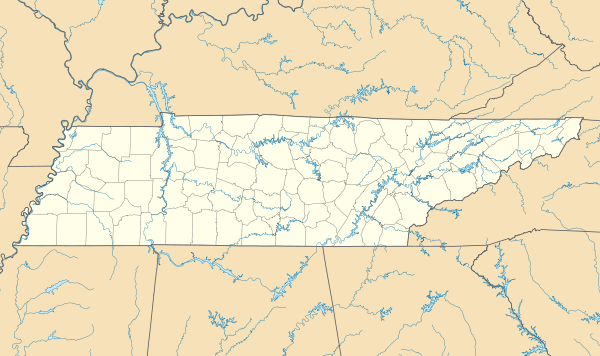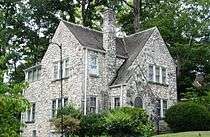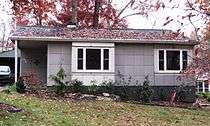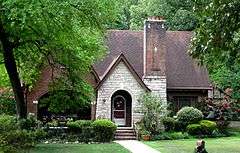Lindbergh Forest, Knoxville, Tennessee
|
Lindbergh Forest Historic District | |
|
Tudor Revival-style house at 3419 Southwood Drive, built c. 1929 | |
  | |
| Location |
Along Chamberlain, Druid, Glenhurst, Southwood, Winslow, and Woodlawn Knoxville, Tennessee |
|---|---|
| Coordinates | 35°56′35.45″N 83°54′26.73″W / 35.9431806°N 83.9074250°WCoordinates: 35°56′35.45″N 83°54′26.73″W / 35.9431806°N 83.9074250°W |
| Area | approximately 25 acres (10 ha)[1] |
| Built | 1929–1947[1] |
| Architectural style | Tudor Revival, Colonial Revival, Spanish Revival, Lustron[1] |
| NRHP Reference # | 94001261[2] |
| Added to NRHP | February 10, 1998[1] |
Lindbergh Forest is a neighborhood in Knoxville, Tennessee, United States, located off Chapman Highway (US-441) in South Knoxville, that is listed on the National Register of Historic Places as an historic district. Initially developed in the late 1920s as one of Knoxville's first automobile suburbs, the neighborhood is now noted for its late-1920s and early-1930s residential architecture, and the use of East Tennessee marble detailing. The neighborhood also contains two of Knoxville's five surviving Lustron houses. In 1998, several dozen of its houses were added to the National Register of Historic Places as the Lindbergh Forest Historic District.[1]
Location
Lindbergh Forest is situated in an area roughly bounded by Chapman Highway on the west, Woodlawn Pike on the north and east, and Moody Avenue on the south. It includes Druid Drive, Chamberlain Boulevard, Winslow Drive, Tall Oaks Drive, Southwood Drive, Glenhurst Drive, Winslow Drive, and parts of Woodlawn Pike. A newer section of the neighborhood, commonly called "Taliwa," is located along Taliwa Drive and adjacent streets.
The Lindbergh Forest neighborhood is heavily wooded, with numerous mature trees, and contains streets which follow the natural topography. This setting provides a stark contrast with the busy sprawl along adjacent areas of Chapman Highway.
History

In the late 1920s, real estate developer Victor McClain purchased what is now the Lindbergh Forest area from Samuel B. Luttrell (son of former Knoxville mayor James C. Luttrell). McClain, who had made a fortune developing subdivisions in Florida, hoped to develop a neighborhood catering to Knoxville's rising number of automobile commuters during this period. While similar "automobile suburbs" were being developed elsewhere in Knoxville at the time (e.g., North Hills, Sequoyah Hills, and Forest Heights), the lack of an adequate vehicle bridge across the Tennessee River made such development in South Knoxville risky. The completion of the Henley Street Bridge in 1931, however, alleviated this problem, and the first lots sold well.[3]
As part of a promotional campaign, McClain offered $100 to whoever could come up with the best name for the new neighborhood. The winning entry, "Lindbergh Forest," was suggested by Emilee Cate. She submitted the name in honor of aviator Charles Lindbergh, who had completed his famous trans-Atlantic flight in 1927.[3] Cate was the wife of Sheriff J. Carroll Cate, who as a deputy sheriff had unsuccessfully defended the Knox County Jail from a lynch mob during the Riot of 1919.[3] The Cates lived on Chamberlain Boulevard.[3]
Early residents of Lindbergh Forest included local business owners, local politicians, University of Tennessee professors, and Tennessee Valley Authority employees. During the 1930s, three consecutive mayors of Knoxville lived in Lindbergh Forest— John T. O'Connor, James Elmore, Sr., and Walter Mynatt. One resident, Dewey Holt, owner of the United Milk and Grocery Company, was reputedly a local bootlegger. When new residents moved into his house in the 1980s, they found hundreds of liquor bottles scattered around the house and grounds.[3]
The completion of the Henley Street Bridge and the creation of the Great Smoky Mountains National Park led to increased development along Chapman Highway, and the residents of Lindbergh Forest have continuously fought to stave off commercial encroachment into their neighborhood. Over the past several years, the neighborhood has successfully prevented the construction of numerous commercial establishments, including a manufacturing plant, a beauty salon, and a slaughterhouse.[3]
Lindbergh Forest Historic District

The Lindbergh Forest Historic District consists of 38 contributing houses and 10 contributing garages, all built between 1929 and 1947. The streetscapes and lamp posts have been included collectively in the listing as a contributing site. The Tudor Revival style is the most common architectural style in the district. Colonial Revival, Minimal Traditional, Bungalow, Spanish Eclectic, and Modern styles are also represented.[1] The district includes two Lustron houses, which were a type of pre-fabricated house designed by the Lustron Corporation to meet post-World War II housing shortages.[1]
The lamp posts in Lindbergh Forest remain from the early stages of the neighborhood's development. The posts, designed to resemble colonial-era gas lights, are 8 feet (2.4 m) tall and topped with wrought iron fixtures.[1]
Notable houses
- 214 Druid Drive, a one-story Tudor Revival-style house built c. 1930. The house's exterior consists of stone with East Tennessee marble window sills.[1]
- 240 Druid Drive, a 1 1⁄2-story Spanish Eclectic-style house built c. 1929. The exterior consists of course limestone walls with East Tennessee marble trim.[1]
- 244 Druid Drive, a two-story Tudor Revival-style house with Colonial influence, built c. 1929. The house's exterior consists of rubble-coursed limestone veneer with brick trim.[1]

- 222 Chamberlain Boulevard, a one-story Lustron house built c. 1947.[1]
- 229 Chamberlain Boulevard, a two-story Eclectic house with Tudor Revival and Chateauesque influence, built c. 1930. The house's exterior consists of East Tennessee marble.[1]
- 254 Chamberlain Boulevard, a two-story Tudor Revival-style house with limestone exterior, built c. 1929. This house is listed in the National Register nomination form as "214 Chamberlain."[1]
- 301 Chamberlain Boulevard, a 1 1⁄2-story Tudor Revival-style house with Chateauesque influence, built c. 1929. The exterior consists of rusticated limestone with East Tennessee marble trim. This house is listed in the nomination form as "201 Chamberlain."[1]
- 306 Chamberlain Boulevard, a one-story Mission-style house with Spanish Colonial influence, built c. 1929. The house has stuccoed walls and a terra cotta tile roof.[1]

- 3419 Southwood Drive, a one-story Tudor Revival-style house built c. 1929. The house's exterior consists of brick and limestone,[1] and includes an arched porch and a chimney with inset cross pattern.
- 3514 Southwood Drive, a 1 1⁄2-story Tudor Revival-style house with Minimal Traditional influence. The house's exterior consists of coursed East Tennessee marble rubble.[1]
- 327 Winslow Drive, a one-story Colonial Revival-style house built c. 1937. The house's exterior consists of brick veneer with East Tennessee marble trim.[1]
- 3510 Glenhurst Drive, a one-story Lustron house built c. 1947.[1]
References
- 1 2 3 4 5 6 7 8 9 10 11 12 13 14 15 16 17 18 19 20 Ann Bennett, National Register of Historic Places Nomination Form for Lindbergh Forest Historic District, May 1994.
- ↑ Nationalregisterofhistoricplaces.com. Retrieved: 8 November 2010.
- 1 2 3 4 5 6 Barbara Asbury, "Lindbergh Forest: A Treasure from the 1920s is Tucked into a Tree-Lined Pocket South of the River." Knoxville News-Sentinel, 19 February 1998.
External links
| Wikimedia Commons has media related to Lindbergh Forest Historic District. |
